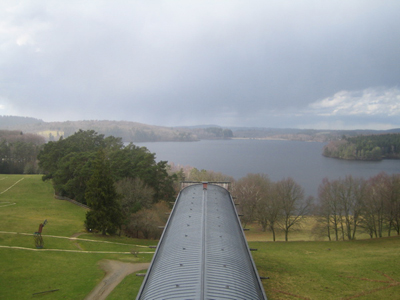Can a blog be a memory? What I mean is in all blogs, like in all films, what is being described has always already passed, but a film isn’t a webcam and a blog isn’t a tweet, right? Which is as much to say that I’ve had this one in my head for a couple of months now – though that doesn’t help the peculiar kind of unreality that had or is unfolding. I wrote the first sentence in my head towards the end part of an hour-long car ride from the airport in Limoges to the art centre on the Île de Vassivière, really almost literally to a map pin in the entirely drenched, artificial heart of France. It went something like: “With every hairpin turn the road was tightening like a spring.” But even then it wasn’t reportage.
It’s one of the ironies of green politics that it is only in green places – like the countryside – where you actually really need a car. You’re not free in the countryside, you are in a car. And there I was, in it and in one, going to see Rosa Barba’s show (she’s a friend and I’m writing a catalogue essay) at the Centre International d’Art et du Paysage de l’Île de Vassivière – an extraordinary postmodern building designed by Aldo Rossi and Xavier Fabre. There was a well-worn look of pleasure on the face of the person driving as she anticipated my shock at leaving the last cash machine for twenty miles (“you won’t need any cash anyway”) and as the roads got smaller, more life-threatening etc.
I like the countryside, I don’t feel displaced there. But an art centre in the middle of a vast manmade lake which it overlooks, reached only by a single concrete bridge that visitors usually have to cross on foot (15mins), out of season, in cold rain, where you stay in the nearest hotel from and to which you are dependent on being shuttled (in a car) where you are the only guest sat at the one table laid for breakfast (your table) and it is only your feet creaking the floorboards – … well, then maybe I start to feel this kind of self-consciousness that could be called displacement.
Or at least in this place that’s so precisely, almost perfectly difficult to get to, it being just me, these artworks and a building, I start to wonder about what kind of viewer am I, or what kind of viewer does this place determine? Any or none? Am I the none? What is public and am I it or is nobody? Didn’t Robert Smithson once write that the perfect museum would be the one without any people in it, the one you couldn’t enter? Is the closed circuit of this place and me (in cars), it? Is anybody else here?
Which is not to say that the work did not riff on just questions. Barba’s film and sound installations were organised in a way that made the building here itself and its surroundings into an emblem – an imaginary machine – of projection and projections and different acts of looking. From the doors of the art centre’s faux lighthouse a 35mm projector shone its lamp into the building proper, its film loop flapping and sucked meters up to its zenith and so visitors – I – were projected into this long skinny space.
There was a new film, The Long Road – an aerial view of a temporary track for testing cars etched into the Californian desert like a perfect oval, a closed loop. 16mm projectors were circuit bound by the looped clear film they were projecting, wrapped in it, suspended by it. It was as if in walking through Rossi and Fabre’s long rooms and gangways I too was being propelled or projected right to the building’s very end where I was stopped dead short by the back wall of a lecture space without any chairs in which was a small square window – not so much the perfect museum as the final, perfect, epic projection box and this room is called White Museum.
Visible only at night, from a ‘secret room’ below that is accessible only on demand, through this small square window another 70mm projector played clear leader onto an impeccable landscape and an almost-still lake below that it lights in an approximate rectangle, as if to light nature were to record it. The scale of this remarkable turning of tables was such that the idea of this work was only ever on the tip of my tongue and never fully spoken. It was as if these things that existed in general now only existed because of this light, like a museum that nobody (else) could enter.
Or like a person trapped by a memory or a memory trapped in a person. Which like I say is what this is now, in fact what aspects of London are to me now, because since then I packed up all my things and sent them to my mum’s in Dagenham, took the number 43 to London Bridge and ‘find’ myself living ‘between’ Berlin (weighted in the equation 3:1) and there, now. Weird, but good.
Rosa Barba, ‘Is is a two dimensional analogy or a metaphor?’, Centre International du Art & du Paysage de l’Île de Vassivière, to 4 July 2010.
Ian White is an artist and Adjunct Film Curator for the Whitechapel Gallery, London, as well as working on independent projects. He is the Facilitator of the LUX Associate Artists Programme and a writer. He curated ‘Tense Present’, a guided tour of artists’ film and video in the Luxonline collection. ‘IBIZA: a reading for “The Flicker”, Black Flags and Democracy’, three solo performances and a window display by Ian White will be presented at daadgalerie in Berlin, 3-17 July 2010.



